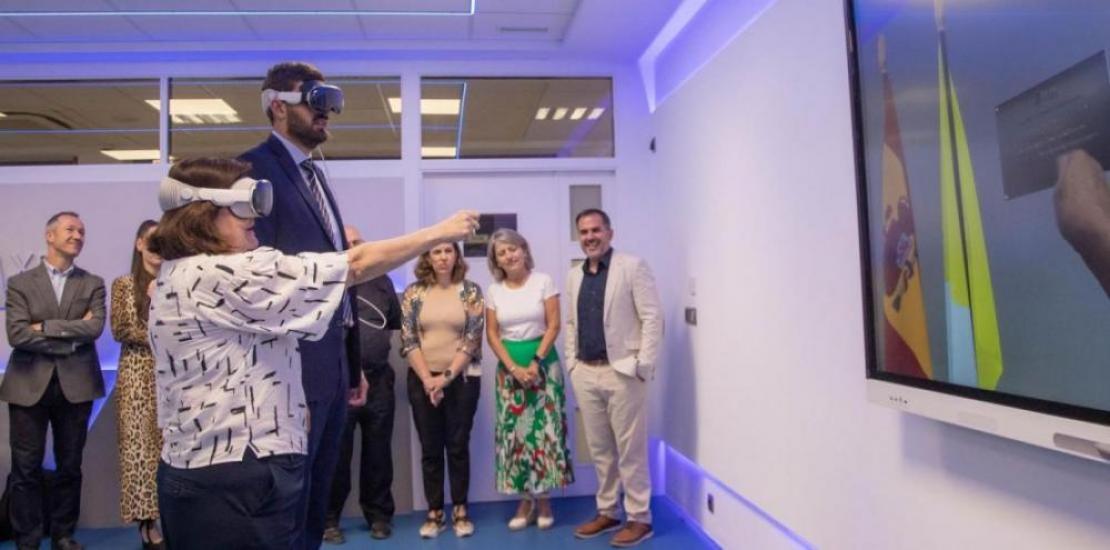UCAM inaugurates its Virtual Reality and Spatial Computing Classroom
The Universidad Católica San Antonio de Murcia (UCAM), positioned at the forefront with the application of the most modern technology to teaching and research, inaugurated its Virtual Reality and Spatial Computing Classroom today, a space equipped with the latest immersive technologies to revolutionise learning in various academic and professional fields.
María Dolores García, UCAM president, and José Ángel Antelo, vice-president of the Regional Government of the Region of Murcia were present, as well as members of the UCAM Governing Council and the Space Computing team. During the ceremony, in which José Alberto Cánovas, Vice-Rector of Religious Affairs, blessed this brand-new space, the importance of this new classroom was highlighted as a milestone in higher education and its potential to enhance the students' learning experience.
Cutting-edge technology for a transformative educational experience
This classroom is equipped with state-of-the-art devices, such as more than 60 virtual reality goggles, including the Apple Vision Pro, Meta Quest 3 and Meta Quest Pro, available for students. These technologies enable an immersive learning experience, which has already proven to be very effective in the training of students in health sciences degrees, particularly in Medicine and Nursing.
Its students have used these technologies to practice and learn critical procedures such as triage and disaster management, as well as basic and advanced Cardiopulmonary Resuscitation (CPR) . One of the most outstanding experiences was the simulation of medical emergencies on board a Helicopter Emergency Medical Service (HEMS), where the students attended to patients with cardiorespiratory arrest in hypothermic conditions.
The UCAM Virtual Reality and Spatial Computing Classroom is also equipped with the latest devices in digital twin generation, using the most advanced LiDAR sensors. These sensors enable the creation of accurate digital replicas of physical objects and environments, facilitating detailed simulations and complex analyses in real time. This technology is crucial for fields such as architecture, as it allows to visualise and modify projects in a virtual environment before construction, and in the health sciences, to train within the digital twins of hospital areas prior to face-to-face practices.
In addition, the classroom is equipped with motion capture devices, which allows to record and analyse human movements with high accuracy, which is essential for disciplines such as sport and physical rehabilitation, as well as haptic vests, which provide tactile feedback, enhancing immersion in virtual simulations by allowing users to physically feel the interactions in the virtual environment.
It is not only university students who will benefit from this innovative classroom, but also practising professionals such as health scientists, firefighters, law enforcement and other specialists who can take advantage of intensive and realistic training in simulated environments.
José Ángel Antelo, Vice-President of the Regional Government of the Region of Murcia, highlighted the possibility of collaborating with UCAM for the training of local police and emergency services, as ‘it is essential to be prepared for emergency situations, and this type of training and collaboration are important steps in that direction’, adding that ‘it is comforting to know that funds are being invested in innovative technology to support those who risk their lives to protect others’.
Manuel Pardo, principal investigator of the Research Group on New Technologies for Health Highlighted that ‘we are pioneers in immersive technologies, and in this classroom, each student has his or her own device; everyone has access to virtual spaces, the metaverse, virtual and augmented reality through different types of equipment. For teachers, it offers a new resource and possibilities that were previously unimaginable.’
Pau Guardiola, director UI/UX Multimedia, highlighted the applications that students are already using: ‘Indeed, in this room we have already had immersive experiences that have taken our students into situations of building collapse, such as the earthquake in Turkey, or inside a human body. It is exciting to see the interest of the teachers in going a step further for their students and then, of course, the experience of the students who appreciate it and learns more, which is the objective.




